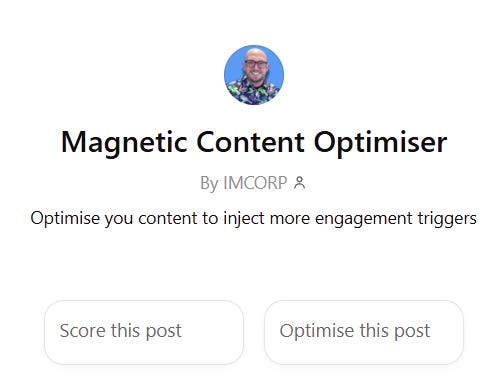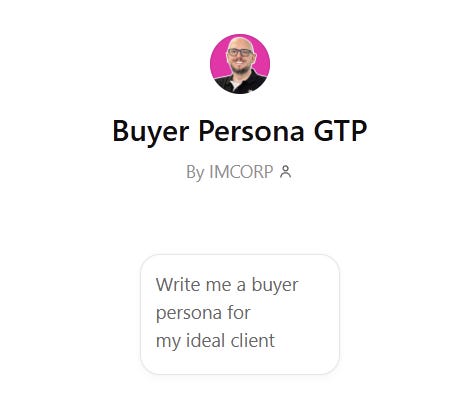3 Ways AI can get you clients on LinkedIn
There’s a lot of hype around AI right now, and most of it isn’t helping. This is how AI gets people to DM you asking for your help
If you prefer a video version of this, It’s over on my LinkedIn (just click here)
There’s a lot of hype around AI right now, and most of it isn’t helping.
What started as a genuinely useful tool has become another excuse for overproduction.
You’ve probably seen the posts.
AI-generated clones of someone else’s content, stripped of originality and packed with em-dashes (—), rocket emojis and empty claims.
This isn’t that.
AI, used well, doesn’t replace you.
It doesn’t take over your content, automate your voice, or spit out some magical 30-day pipeline.
That’s not what gets clients.
What gets you inbound leads
Inbound leads don’t come from promoting your programme or posting a countdown to your next launch.
They come when someone sees your content and thinks, “That’s exactly how I feel. You’ve just described what I’m going through, and it sounds like you’ve got a way through it.”
That’s what prompts them to message you.
Not because you pitched.
Because you resonated.
If you want more inbound leads, your content needs to show that you understand the problem the way they experience it, not in expert language, not from your perspective, but from theirs.
Describe what it looks like, what it feels like, and what they’ve already tried that hasn’t worked. Then show how you approach it differently and what changes as a result.
When your content does that, people reach out. Not because you asked them to. Because they feel seen.
Used properly, AI helps you do that faster and with more focus.
You don’t need to learn clever prompts or buy new tools. You just need to know what to ask, how to apply the insight, and how to keep it sounding like you.
Here are three ways I use AI to get clients on LinkedIn.
You can apply them today.
No automation.
No gimmicks.
Just sharper, better messaging that speaks to the right people.
#1 - Use AI to understand your clients’ world in their words
Most people jump into content creation by asking what they should post. But content that converts doesn’t start with ideas. It starts with insight.
If you want to create posts that bring in leads, you need to understand how your audience sees the problem, not how you see it. There’s often a huge disconnect between what you think is going on and how they’re actually experiencing it.
You’ve probably solved the problem you help with.
You’ve got perspective.
They don’t.
That means your content needs to speak from inside the problem, not from the outside looking in.
Open ChatGPT and use this simple prompt:
I want to think like my ideal client. They are [your ideal client] and they want to get [end result you deliver]. What might be their biggest struggles, challenges and frustrations - also their fears, dreams and doubts. I want to understand these in their own words, not expert lingo or waffle.
You’ll get back a range of emotional triggers and common phrases.
These are the entry points that make someone stop scrolling and think, “That’s exactly how I feel.”
From there, you can structure a post or message that reflects that experience.
Here is a simple posting structure:
What is the problem
What it feels like
What have they been trying and how does that feel
How you approach the problem
What changes and how it feels now
Introduce your approach in plain terms.
Avoid turning it into a promotion.
The bit where you talk about yourself should not take up too much time, short and simple.
The reason they’ll enquire is because they want to know more, not because you gave them every last detail.
⭐Bonus - AI Optimiser
Once you’ve written a draft, you can run it through my content optimiser.
It doesn’t write your post for you.
Instead, it gives you a score based on emotional depth, clarity, and resonance, and tells you where the gaps are.
Then it optimises posts to add depth, substance and emotional triggers.
You author it.
It will optimise it.
It’s a quick way to sharpen your message before you publish.
Try it out here [bookmark it for future]
#2 - Use LinkedIn URLs to understand your prospects quickly
This part is simple, but very few people do it.
Instead of writing generic posts or outreach messages, start by looking at the actual people you’re trying to reach. Take a real LinkedIn profile someone who looks like your ideal client and drop the URL into ChatGPT.
Then ask something like this:
Review Terry’s profile - https://www.linkedin.com/in/mrtheath/
Terry is similar to my ideal client. I want to market to him my [offer], what might his objections and reasons to buy be? My price point is [$X] and the result from my offer is [outcome].
ChatGPT will scan the available information and give you a rough profile of what matters to that person.
It might flag time constraints, fear of being visible, or concerns about ROI.
Ask follow up questions / instructions like:
What content would help me at the Top, Middle and Bottom of Funnel to get Terry to by my offer?
How can I position myself as an expert for Terry?
What lead magnets could I create to setup my offer with Terry?
Review my landing page, tell me what parts would and wouldn’t resonate with Terry.
You can even go a step further and ask it to draft a message based on that person’s tone, or suggest blog post topics that would resonate with them specifically.
This process isn’t about writing for one person.
You could follow up giving 4 or 5 more and compare them against each other.
It’s about building sharper, more specific messaging by analysing a few people who represent your audience.
You’ll start to see patterns.
The objections repeat.
The fears overlap.
And suddenly, you’re writing from a place of relevance instead of assumption.
It also gives you natural material for content.
If someone like Terry, for example, might be thinking “I’m already posting consistently why would I need this,” that becomes a post.
You don’t need to guess what to say.
The questions and hesitations are right in front of you.
#3 - Use those insights to create messaging that actually lands
Once you understand how your audience experiences the problem, and you’ve validated it by looking at real profiles, you’re in a position to write with clarity.
Most people stop short of this.
They gather ideas, but then let AI generate the content.
The content still needs to sound like you.
What AI can do is help you develop and refine the message, not replace it.
In the same chat, you can ask about the best way to outreach to Terry:
Based on [insert LinkedIn profile URL], create a 14-day engagement plan focused on building a genuine connection with this prospect.
Assume they don’t post daily, so include a mix of actions that work even when they’re not active. The goal is not to go straight for the sale, it’s to build rapport, trust, and relevance first, and only reach out once there’s enough familiarity and context.
The plan should include daily actions across:
– Rapport building (e.g. soft touches, shared experiences, thoughtful engagement)
– Trust building (e.g. helpful comments, insights, low-pressure value adds)
– Authority positioning (e.g. content that signals expertise in their world)
– Subtle curiosity and desire (e.g. priming them to be open to a future offer)End the plan with a natural, conversational outreach message via DM or email that feels relevant, not random, pitchy, or out of the blue.
Build your posts or message using the structure I outlined earlier.
The problem and how it feels.
What they’ve already tried. Your approach. What changes afterwards.
Then refine it.
Keep it simple.
Cut anything that sounds like it was written for a conference room.
And remember that people decide emotionally and justify logically.
If your post doesn’t reflect how the problem feels, it won’t land, no matter how logical it sounds.
⭐Bonus - Buyer Persona GPT
You can go one step further and use my Buyer Persona GPT.
It allows you to build a buyer persona using real LinkedIn profiles.
You paste in a few URLs, answer a few simple questions about what you offer, and it builds a persona you can work from.
It covers pain points, messaging angles, content topics, common objections everything you need to write more strategically.
Once the persona is built, you can use it to brainstorm post ideas, refine your messaging, or even test your current offer. If you want access, just message me and I’ll send it over.
Don’t think of this as a “find my buyer persona”
Once it has written the persona… ask it questions:
What are your biggest fears about [x]?
What are the problems you have which I might miss?
What might be my blind spots in trying to market to you?
What content will resonate with you about [x] topic?
Bookmark the chat, keep coming back to it, use it as a sounding board.
Try it out here [Bookmark this link]
A reminder…
AI won’t make you go viral.
But it can make you more relevant.
It helps you think more clearly, write with more focus, and create messaging that reflects what your clients actually care about.
It doesn’t replace your voice. It strengthens it.
You don’t need some new shiny tech. Just one that will help you write better, sell more, and show up with clarity.
This is how I use AI to get clients on LinkedIn.
You can do the same.






